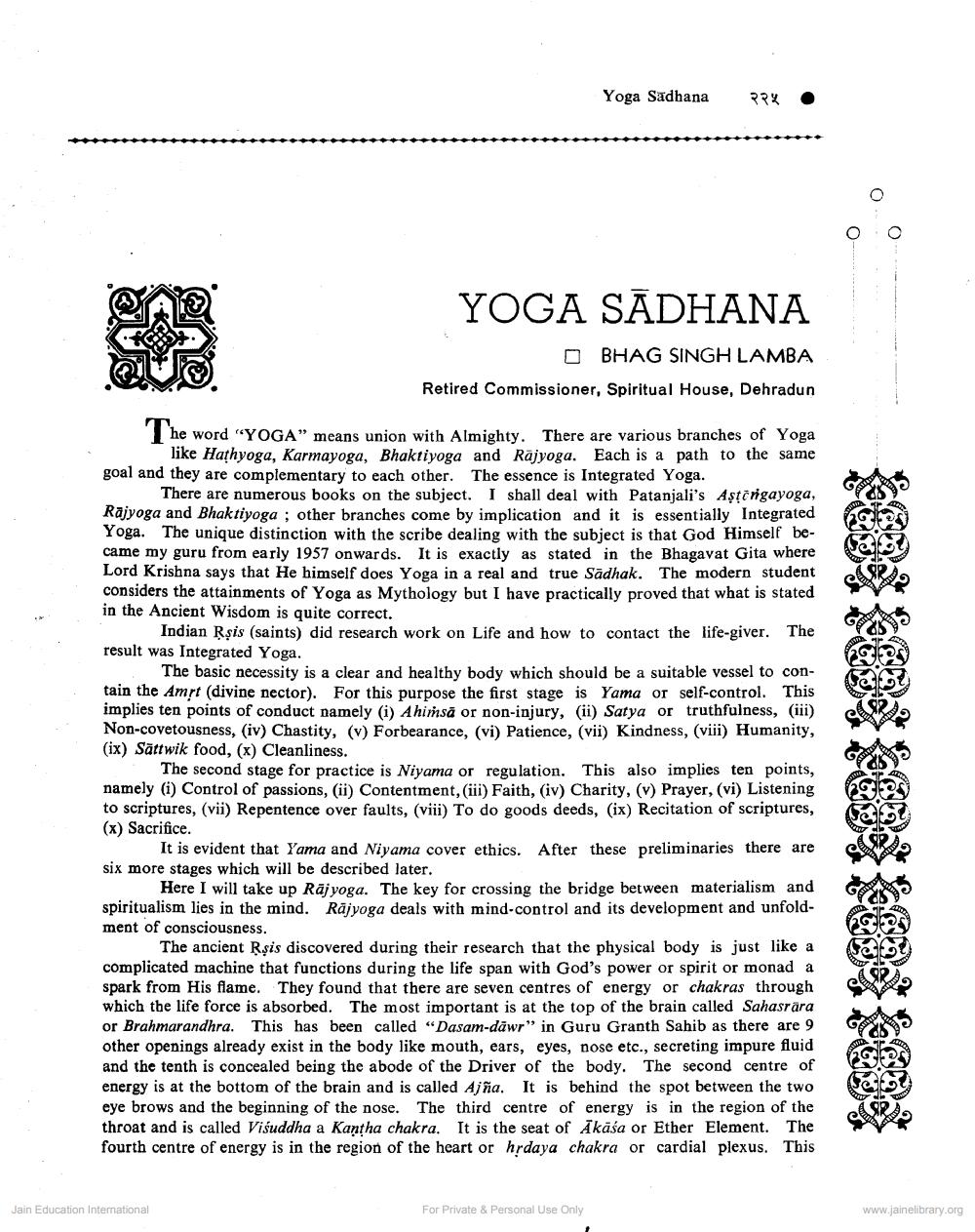________________
Yoga Sadhana
२२५
.
YOGA SADHANA
BHAG SINGH LAMBA Retired Commissioner, Spiritual House, Dehradun
The word "YOGA” means union with Almighty. There are various branches of Yoga
like Hathyoga, Karmayoga, Bhaktiyoga and Rajyoga. Each is a path to the same goal and they are complementary to each other. The essence is Integrated Yoga.
There are numerous books on the subject. I shall deal with Patanjali's Aşterigayoga, Rajyoga and Bhaktiyoga ; other branches come by implication and it is essentially Integrated Yoga. The unique distinction with the scribe dealing with the subject is that God Himself became my guru from early 1957 onwards. It is exactly as stated in the Bhagavat Gita where Lord Krishna says that He himself does Yoga in a real and true Sadhak. The modern student considers the attainments of Yoga as Mythology but I have practically proved that what is stated in the Ancient Wisdom is quite correct.
Indian Rsis (saints) did research work on Life and how to contact the life-giver. The result was Integrated Yoga.
The basic necessity is a clear and healthy body which should be a suitable vessel to contain the Amrt (divine nector). For this purpose the first stage is Yama or self-control. This implies ten points of conduct namely (i) Ahimsa or non-injury, (ii) Satya or truthfulness, (iii) Non-covetousness, (iv) Chastity, (v) Forbearance, (vi) Patience, (vii) Kindness, (viii) Humanity, (ix) Sättwik food, (x) Cleanliness.
The second stage for practice is Niyama or regulation. This also implies ten points, namely (i) Control of passions, (ii) Contentment, (iii) Faith, (iv) Charity, (v) Prayer, (vi) Listening to scriptures, (vii) Repentence over faults, (viii) To do goods deeds, (ix) Recitation of scriptures, (x) Sacrifice.
It is evident that Yama and Niyama cover ethics. After these preliminaries there are six more stages which will be described later.
Here I will take up Rajyoga. The key for crossing the bridge between materialism and spiritualism lies in the mind. Rajyoga deals with mind-control and its development and unfoldment of consciousness.
The ancient Rsis discovered during their research that the physical body is just like a complicated machine that functions during the life span with God's power or spirit or monad a spark from His flame. They found that there are seven centres of energy or chakras through which the life force is absorbed. The most important is at the top of the brain called Sahasrara or Brahmarandhra. This has been called “Dasam-dāwr" in Guru Granth Sahib as there are 9 other openings already exist in the body like mouth, ears, eyes, nose etc., secreting impure fluid and the tenth is concealed being the abode of the Driver of the body. The second centre of energy is at the bottom of the brain and is called Ajña. It is behind the spot between the two eye brows and the beginning of the nose. The third centre of energy is in the region of the throat and is called Visuddha a Kantha chakra. It is the seat of Ākāśa or Ether Element. The fourth centre of energy is in the region of the heart or hrdaya chakra or cardial plexus. This
Jain Education International
For Private & Personal Use Only
www.jainelibrary.org




